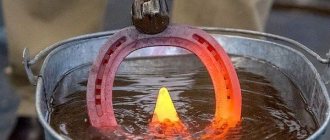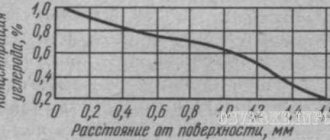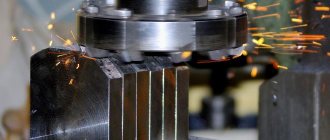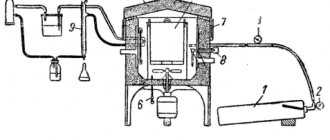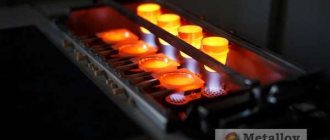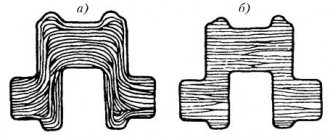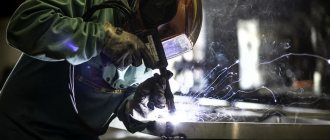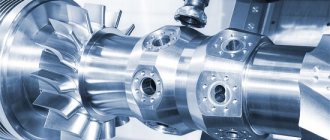Ceramic cutting tools (ceramic inserts) based on aluminum oxide are an attractive alternative to carbide tools for machining hardened steel. These ceramic cutting tools can handle high cutting speeds and provide good surface finish. The wear mechanism of these ceramic cutting tools must be properly understood for greater use. In our study, two types of ceramic cutting tools are used, namely Ti[C,N] mixed alumina ceramic cutting tool and zirconia-hardened alumina ceramic cutting tool. The machinability of hardened steel was evaluated by measuring tool wear, cutting forces, and workpiece surface finish. These aluminum oxide ceramic cutting tool materials provide good surface finish when cutting hardened steel. This paper attempts to analyze the important wear mechanisms such as abrasive wear, adhesive wear and diffusion wear of these materials for ceramic cutting tools, and the performance of these ceramic cutting tools related to surface finishing is also discussed here.
Advances in ceramic cutting technology have resulted in a new generation of highly efficient ceramic cutting tools with improved properties. Improvements have been made in tool properties such as tensile strength, toughness, heat resistance, hardness and wear resistance. These developments have made it possible to use ceramic tools to machine various types of steel, cast iron, non-ferrous metals and refractory nickel-based alloys at high speeds. Aluminum oxide is widely used as a material for ceramic cutting tools and is strengthened by the addition of particles such as zirconium oxide, titanium carbide and titanium nitride to improve properties. The mechanisms of strengthening or hardening of these ceramic composite materials are phase change strengthening and precipitation or dispersion strengthening.
Zirconia strengthened alumina consists of partially stabilized zirconia particles dispersed in an alumina matrix.
Zirconium exists in three well-defined polymorphs: cubic (c) (above 2370 °C), tetragonal (t) (between 2370 and 1150 °C) and monoclinic (m) (below 1150 °C). High temperature phases can be stabilized to room temperature by adding dopants such as nitrate, cerium and magnesium [1]. The T phase, which is a metastable phase at low temperature, requires energy to transform into the stable low temperature m phase. Since this conversion of t to m absorbs energy, and the ability to absorb energy creates toughness, the conversion of t to m results in an increase in the toughness of the material. This phenomenon is known as hardening transformation. When zirconia is toughened with alloying substances such as yttrium, cerium and magnesium using the above-mentioned transformation hardening, it is called transconcentrated zirconia (TCZ). The incorporation of sufficient zirconia into the traditional alumina matrix has led to the development of zirconia strengthened alumina (ZTA) with improved toughness. In ZTA, zirconia undergoes limited transformation, the confining matrix being alumina, which has a higher elastic modulus and lower thermal expansion than TTZ. Tetragonal monoclinic transformation is considered to be martensitic in volume and is accompanied by an increase in volume. When pure zirconia is dispersed in an alumina matrix, the zirconia retains metastable tetragonal particles that are confined by a rigid matrix that prevents volume expansion associated with phase change. When alumina-tetragonal zirconia composites are loaded, the tensile strain field surrounding the crack tip transforms the zirconia particles, which expand and generate compressive strain in the matrix, and the tensile stress at the crack tip is reduced. This stress-induced transformation increases the fracture toughness of zirconia-strengthened alumina composites [2]. Zirconium dioxide particles dispersed in the alumina matrix also increase fracture toughness due to the formation of a high density of microcracks that absorb energy due to their slow propagation. Microcracks are formed as a result of the expansion of ZrO2 during the tetragonal to monoclinic transformation.
Another important type of alumina ceramic cutting tool is the alumina composite tool mixed with Ti[C,N]. By adding these non-oxide particles such as TiC and TiN to the alumina matrix, thermal conductivity, heat resistance and hardness are increased. These composite ceramic cutting tools maintain their hardness even at elevated temperatures. The addition of particles such as TiC and TiN increases the transverse tensile strength of the composite compared to white alumina ceramic cutting tools. In a cutting tool made of composite ceramic alumina mixed with Ti[C,N], TiC, TiN grains fix the crack that occurs in the matrix. This is due to the fact that additional energy is required to propagate a crack around particles [3]. In this type of ceramic composite cutting tool, TiC and TiN particles act to anchor stress-induced dislocation motion in the alumina matrix. The hardening mechanism for this type of mixed ceramic cutting tools is known as sediment or dispersion hardening. In precipitate- or dispersion-strengthened materials, when a dislocation encounters the precipitate, it will generally not be able to cut through it because the precipitate is stronger than the matrix. Consequently, the dislocation will have to bend between and around the deposits, leaving a dislocation loop around the particle. Thus, the movement of the dislocation is hindered by the TiC and TiN particles dispersed in the alumina matrix, and additional energy is required for the movement of the dislocation [4].
Literature review
With the development of these ceramic composite tools with improved properties, machining steel in the hardened state using alumina ceramic cutting tools has become attractive. Ceramic cutting tools such as zirconia reinforced alumina ceramic cutting tools are called alumina ceramic tools, and TiC and TiN based alumina ceramic cutting tools are called alumina ceramic cutting tools. These ceramic tools can be used for high-speed machining, which promotes efficient use of high-speed machine tools by reducing machining time. Productivity is increased through shorter cycle times and high-speed steel machining using ceramic cutting tools, reducing production costs. The wear behavior of these ceramic cutting tool materials is complex and more information is required on wear mechanisms and improved cutting tool materials to predict performance under given machining conditions. These ceramic composite cutting tool materials are mainly used for machining hard materials such as cast iron, steel, stainless steel under hardened conditions, refractory metals such as nickel-based alloys and composite materials. The need for finishing operations such as grinding can be eliminated with these ceramic composite cutting tools. It has been reported that the transition from coated carbide tools to composite ceramic tools resulted in 2.5 times longer tool life plus higher metal removal rates when machining automotive axle bushings made from ductile iron [5]. Using ceramic inserts, cutting speed can be increased from 183 to 381 m/min. Other machining parameters such as feed speed 0.20mm/rev and depth of cut 0.38mm remain the same. The machining of hardened steel was carried out using zirconia hardened alumina ceramic cutting tools and Ti[C,N] mixed alumina ceramic cutting tools. Hong Xiao [6] conducted research on the wear of various ceramic tools and found that oxide and mixed ceramic tools are more suitable for processing hardened steel than other ceramic tools because of their superior wear resistance. Brandt [7] observed that mixed alumina ceramic tools have better abrasion resistance due to higher hot hardness and greater thermal conductivity than alumina oxide ceramic tools when machining hardened steel. Brandt and Mikus [8] noted that the crater wear of alumina ceramic tools in steel machining was predominantly dependent on surface plastic deformation, and this deformation was strongly influenced by the chemical reaction with the workpiece material. Bhattacharya et al. [9] found that mixed ceramic tools gave better performance than oxide and nitride ceramic tools when machining cast iron. Richards and Aspinwall [10] noted that the tool life of mixed alumina ceramic tools was severely limited due to excessive cutting depth of cut when machining nickel-based alloys. Wayne and Buljan [11] noted that cutting depth of cut was reduced with the addition of SiC whiskers and, to a lesser extent, with TiC particles when machining Inconel 718.
The book is devoted to cutting processing of hardened alloy structural steels. It presents research results and best manufacturing practices in the areas of turning, face milling, drilling, reaming, countersinking and threading of hardened steels. It contains practical recommendations for choosing the design and geometry of the tool, as well as cutting conditions. The book is intended for engineering and technical workers of machine-building plants. It can also be useful to researchers and students of mechanical engineering universities and technical schools.
Size: 16.4 MB Format: djvu Download the book from letitbit.net Download the book from depositfiles.com The link does not work? Write about it in the comments.
Table of contents:
Introduction.
Chapter I. Mechanical properties of hardened alloy structural steels. 1. Classification of alloy steels. 2. Structural alloy steels. 3. The influence of alloying elements on the mechanical properties of structural steels in a highly tempered state. 4. The influence of alloying elements on the mechanical properties of structural steels in a low-tempered (hardened) state. 5. Modern ideas about the mechanical properties of hardened steels.
Chapter II. Metal-ceramic hard alloys and mineral ceramics. 6. General information. 7. Domestic hard alloys. 8. Foreign hard alloys. 9. Mineral ceramics.
Chapter III. Turning of hardened steels. 10. Characteristics of the research conditions conducted by the author. 11. Chip formation. 12. Criterion for blunting the cutter. 13. Selection of hard alloys. 14. The influence of various factors on cutting forces. 15. Geometry of the cutting part of the cutter. 16. The influence of various factors on the durability of the cutter and cutting speed. 17. Surface quality and processing accuracy. 18. Cross shaped turning. 19. Turning with cutters equipped with mineral ceramics. 20. Some issues in the practice of turning hardened steels. 21. Processing of hardened steels by introducing electric current into the cutting zone.
Chapter IV. Face milling of hardened steels. 22. Design of cutters. 23. Blurring criterion and cutter service life. 24. Geometry of the cutting part of the cutter. 25. The influence of various factors on the durability of the cutter and cutting speed. 26. Cutting force and effective power. 27. Cleanliness of the treated surface.
Chapter V. Drilling hardened steels.
Chapter VI. Deployment of hardened steels. 28. Design of reamers and technological equipment. 29. Geometry of the cutting part of the reamer and the grade of hard alloy for equipping it. 30. Reamer wear and criterion for its dullness. 31. Persistent addictions. 32. The influence of various factors on dimensional accuracy and surface finish after deployment.
Chapter VII. Countersinking of hardened steels.
Chapter VIII. Threading on hardened steels. 33. Criterion for blunting the cutter. 34. Determination of the optimal number of passes. 35. The influence of the cutter's transverse feed on its durability. 36. The influence of the radius of curvature of the tip and the rake angle of the cutter on its durability. 37. Selection of hard alloy. 38. The influence of finishing the cutting elements of the cutter on its durability. 39. Dependence of cutting speed on the durability of the cutter, thread pitch and transverse feed of the cutter. 40. Conclusion.
Chapter IX. Some thoughts on physical phenomena during machining of hardened steels. 41. High-speed cutting of hardened flocks. 42. Surface quality during machining of hardened steels. 43. Character of chips and build-up on the cutter when turning hardened steels. 44. About the front and back angles of the cutter when turning hardened steels. 45. Theoretical study of cutting forces when turning hardened steels. 46. Thermo-speed hypothesis for processing hardened steels. 47. The ratio of the hardness of the material being processed and the cutting tool.
Applications. Modes for turning, face milling, drilling, reaming, countersinking and threading of hardened alloy structural steels. References.
Similar books:
- Machine drives: Directory/V. V. Dlougy, T. I. Mukha, A. P. Tsupikov, B. V. Yanush; Under general ed. V. V. Dlougogo. — 2nd ed., revised. and additional - L.: Mechanical Engineering, Leningrad. department, 1982. - 383 p., ill.
Tags: Effect of alloying elements, Countersinking of hardened steels, Classification of alloy steels, Structural alloy steels, Machining of hardened steels, Mechanical properties of hardened alloy steels, Thread cutting on hardened steels, Reaming of hardened steels, Drilling of hardened steels, Turning of hardened steels, Milling of hardened steels
conclusions
The machinability of hardened steel using aluminum oxide ceramic cutting tools was analyzed. Abrasive wear has been found to be the primary wear mechanism in alumina-based ceramic cutting tool materials when machining hardened steel. Both types of ceramic cutting tools undergo gradual gradual abrasive wear with increasing cutting speed. Adhesive wear is higher when processing harder materials. Ti[C,N] mixed alumina ceramic cutting tool material is more susceptible to adhesive wear. Chemically activated diffusion wear is higher in ceramic cutting tool materials mixed with Ti[C,N], but zirconia hardened alumina ceramic tools are not susceptible to diffusion wear. Surface finish improves with increasing cutting speed for both types of ceramic cutting tool materials. The material performance of Ti[C,N] mixed alumina ceramic cutting tool is better in terms of surface finish than that of zirconia reinforced alumina ceramic cutting tool. The performance of ceramic cutting tools has been found to be good when machining steel. Ti[C,N] mixed alumina ceramic cutting tool provides the best surface finish.
Features of stainless steel processing
The tensile strength and hardness values of stainless and carbon steel are almost the same. But it is important to take into account that only the mechanical values are similar, but the microstructure, corrosion resistance, and ability to harden during processing are different. Therefore, processing stainless steel on a lathe has its own characteristics.
There are three main problems that need to be taken into account when processing stainless steel:
- strain hardening;
- limited resource of working tools;
- removal of chips.
When cutting, the alloy is first elastically deformed and subjected to processing, after which it quickly enters the hardening stage. At this stage, cutting can only be done with considerable force. The same processes occur when processing conventional steels, but hardening takes longer.
The low thermal conductivity of stainless steel is its advantage during operation, but during machining it causes additional inconvenience. In the cutting area, the temperature rises significantly, which can lead to the formation of hardening. Peening on a tool can change the shape of the cutting part, so turning stainless steel is performed using a special tool. The cutting speed is low. All turning operations must be carried out with coolant supplied. These compositions not only remove fat, but also prevent the formation of hardening. The processing process is much easier.
Stainless steel perfectly retains strength and hardness even when exposed to high temperatures. These properties, in combination with the resulting hardening, do not allow processing at high speeds, and the working tool quickly becomes unusable. In addition, stainless steels contain carbide and intermetallic compounds, which make the alloys more durable. Friction during processing of stainless steel is significantly higher than during similar operations with carbon alloys. Abrasive compounds contribute to the rapid grinding of cutters; the tool must be constantly adjusted and sharpened.
The tricks of processing stainless steel on a lathe are not limited to this. An additional difficulty can be caused by the toughness of the steel. Because of this, the chips do not break off, as when removing from carbon steels, but curl into a long spiral. The accumulation of long spirals interferes with the turning process. This can be prevented by the use of special chipbreakers and intensive surface treatment with cooling compounds.
When turning stainless steel parts, high-pressure cooling is usually used. The liquid is supplied directly to the processing site, cooling both the part itself and the tool. This allows you to increase the service life of the cutters up to 6 times, but this method also has one disadvantage - high consumption of coolant.
When turning, a specialized chipbreaker with positive geometry is used. This form of chipbreaker reduces the self-hardening of the alloy and prevents the formation of beading on the cutter surface.
